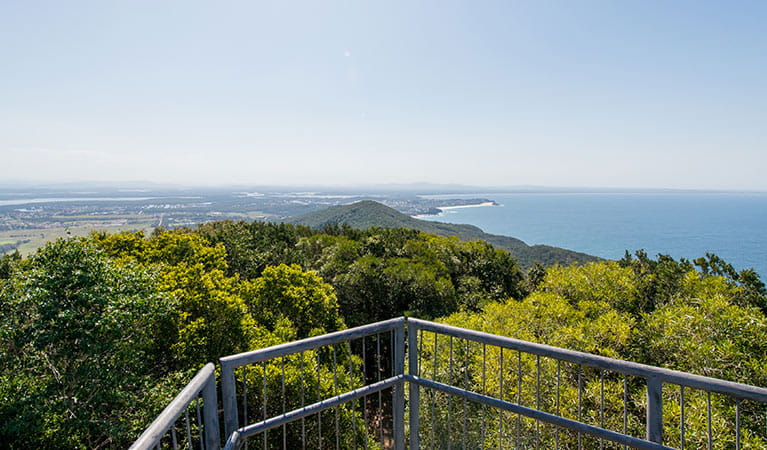Cape Hawke lookout
Booti Booti National Park
Overview
Just five minutes from Forster, the Cape Hawke lookout offers spectacular views along the coast from the top of a dedicated tower, perfect for whale watching.
- Type
- Lookouts
- Where
- Booti Booti National Park in North Coast
- Entry fees
- Park entry fees apply
- What to
bring - Drinking water, hat, sunscreen, insect repellent, sturdy shoes, binoculars
Positioned right at the northern end of the national park, this superb lookout is worth every step of the 500m hike through regenerating littoral rainforest. Pull on your walking shoes and bring some binoculars and a camera – after approximately 420 steps you’ll reach an 8.4m tower with stunning views of the surrounding area.
There’s Booti Booti to the south, and Wallingat National Park beyond and slightly to the west. On a clear day you can even see as far as Barrington Tops and Crowdy Bay National Park.
Birdwatching is wonderful year-round here, with pelicans and terns in great abundance, but winter holds an extra special surprise – whales break the surface of the sea, blowing water, and there’s no better place to watch them in their annual migration.
Also see
-

McBrides Beach walking track
Take a short stroll down McBrides Beach walking track to reach remote and picturesque McBrides Beach, the perfect spot for an oceanside picnic.
-

McBrides Beach
Picnic by the ocean at picturesque McBrides Beach in Booti Booti National Park, 10mins from Forster. Reach this idyllic spot with a short stroll down McBrides Beach walking track.
Map
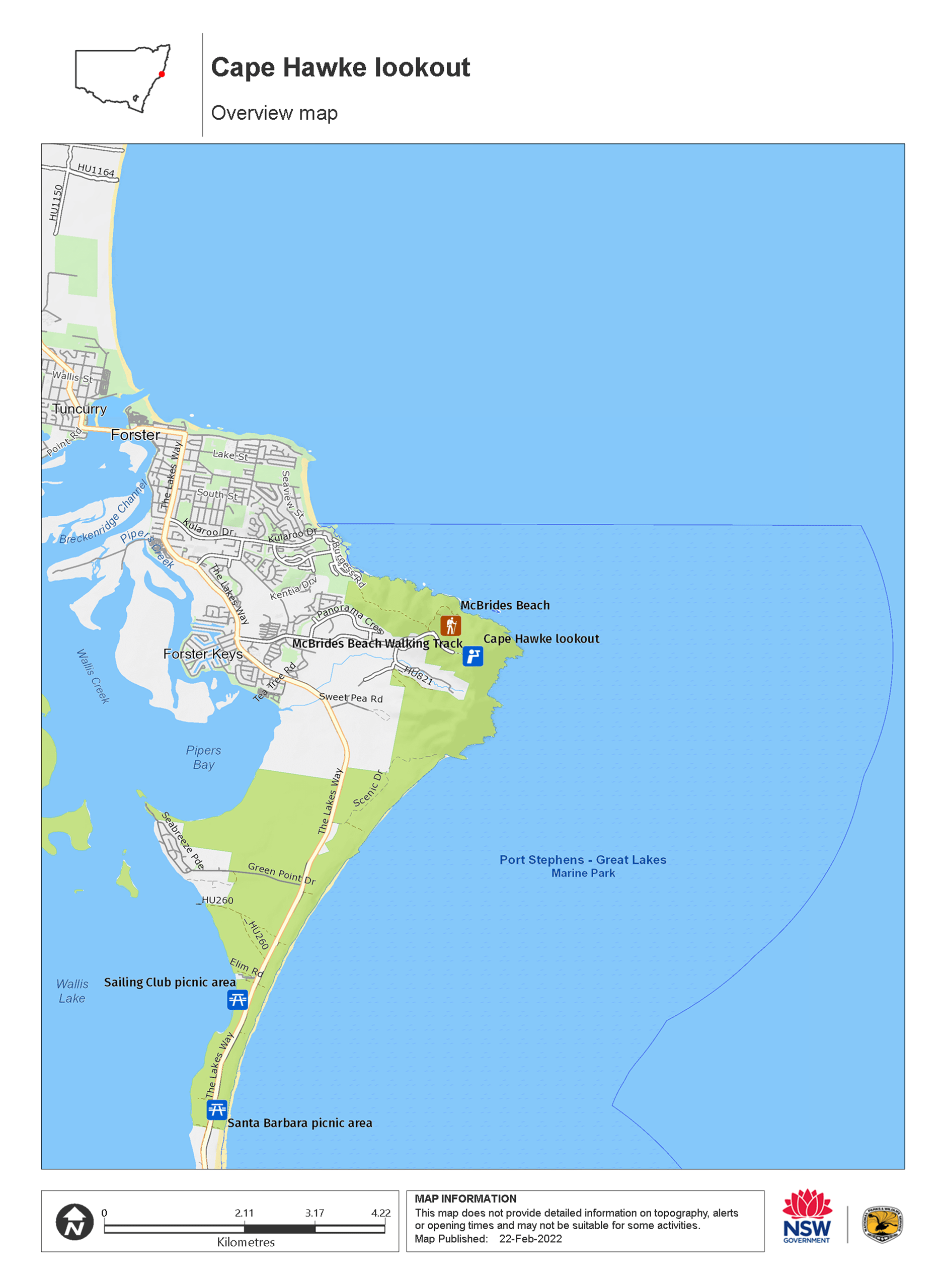
Map legend

Local alerts
For the latest updates on fires, closures and other alerts in this area, see https://www.nationalparks.nsw.gov.au/things-to-do/lookouts/cape-hawke-lookout/local-alerts
General enquiries
- National Parks Contact Centre
- 7am to 7pm daily
- 1300 072 757 (13000 PARKS) for the cost of a local call within Australia excluding mobiles
- parks.info@environment.nsw.gov.au
Park info
- in Booti Booti National Park in the North Coast region
Booti Booti National Park is always open but may have to close at times due to poor weather or fire danger.
-
Park entry fees:
$8 per vehicle per day. Day passes are available from the Manning Great Lakes Area Office, Bulahdelah Visitor Information Centre and the Hawks Nest Newsagency.
Buy annual pass.
Visitor info
All the practical information you need to know about Cape Hawke lookout.
Getting there and parking
Get driving directions
Cape Hawke lookout is in the northern precinct of Booti Booti National Park. To get there:
- From Forster, drive south along The Lakes Way for approximately five minutes
- Turn left into Cape Hawke Drive
- Follow signs to Cape Hawke lookout
Road quality
- Sealed roads
Vehicle access
- 2WD vehicles
Weather restrictions
- All weather
Parking
Parking is available at Cape Hawke lookout including designated bus parking. It can be a busy place on the weekend, when parking might be limited.
Best times to visit
There are lots of great things waiting for you in Booti Booti National Park. Here are some of the highlights.
Spring
See the park's magnificent wildflower displays as they bloom across the heathlands.
Summer
Swim at the seasonally patrolled Elizabeth Beach or kayak in Wallis Lake, whilst staying at the nearby Ruins campground.
Winter
Visit Cape Hawke lookout to watch whales migrating off the coast.
Facilities
Carpark
Maps and downloads
Prohibited
Pets
Pets and domestic animals (other than certified assistance animals) are not permitted. Find out which regional parks allow dog walking and see the pets in parks policy for more information.
Smoking
NSW national parks are no smoking areas.
Learn more
Cape Hawke lookout is in Booti Booti National Park. Here are just some of the reasons why this park is special:
A haven for birds and birdwatchers alike
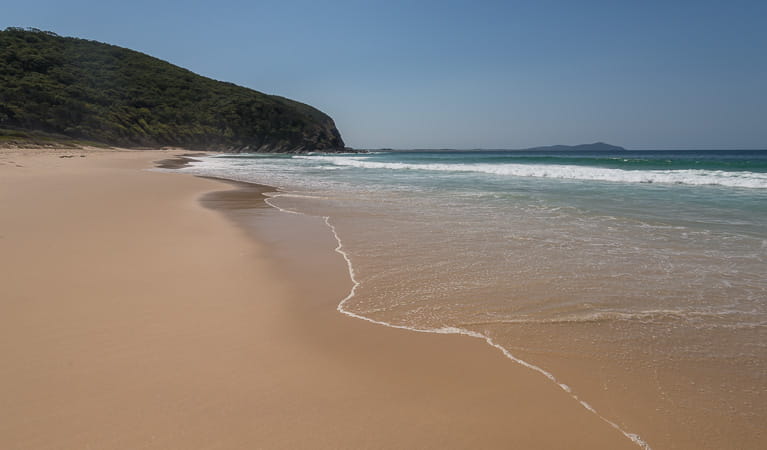
Booti Booti National Park features a substantial number of amphibians and reptiles, including red-bellied black snakes, brown snakes, rose-crowned snakes and blue-bellied swamp snakes. Goannas are regular visitors to The Ruins campground and picnic areas, and you may even be lucky enough to see a land mullet or water dragon. The unusual peninsula between the Pacific Ocean and Wallis Lake also provides an outstanding habitat for over 210 species of birds, including rainbow and scaly-breasted lorikeets, yellow-faced honeyeaters and silvereyes, as well as a number of waterbirds, including pelicans and the endangered little tern.
- Cape Hawke lookout Just five minutes from Forster, the Cape Hawke lookout offers spectacular views along the coast from the top of a dedicated tower, perfect for whale watching.
- Elizabeth Beach picnic area A short drive from Forster, Elizabeth Beach picnic area offers a great spot to relax near a beach popular for swimming in summer and whale watching in winter.
- Junior ranger: Booti Booti coastal adventure tour Join us for a Junior ranger adventure, as we traverse the shores of Seven Mile Beach. Walk alongside a Discovery Ranger to find out what plants and animals live here, and how they survive in this magical environment.
- Sailing Club picnic area An alternative to the ocean-front options of Booti Booti National Park, Sailing Club picnic area offers a shady rest spot on the shore of Wallis Lake.
Aye, Captain
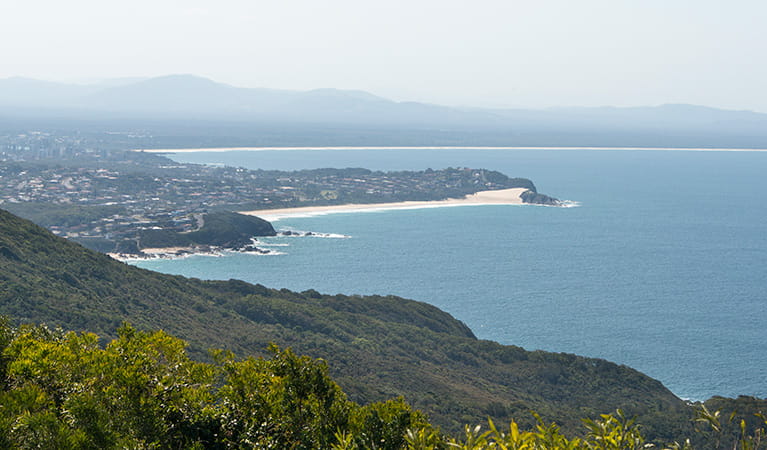
Captain Cook first sighted Cape Hawke on May 12, 1770, and named it in honour of the First Lord of the Admiralty, Edward Hawke. The famous explorer and surveyor John Oxley later passed through the area in 1818. The first European inhabitant was Captain J. Gogerly, who sailed between Forster and Sydney ferrying timber, oyster shells, and sandstone. Today you can pay respects to Captain Gogerly and some of his relatives at their gravemarkers, across the road from the Ruins campground.
- Booti walking track Just 20km from Forster, Booti walking track is a loop walk which beautifully captures the park's scenic features and offers family-friendly opportunities for swimming and picnicking.
- Junior ranger: Booti Booti coastal adventure tour Join us for a Junior ranger adventure, as we traverse the shores of Seven Mile Beach. Walk alongside a Discovery Ranger to find out what plants and animals live here, and how they survive in this magical environment.
Spirituality, identity and lifestyle
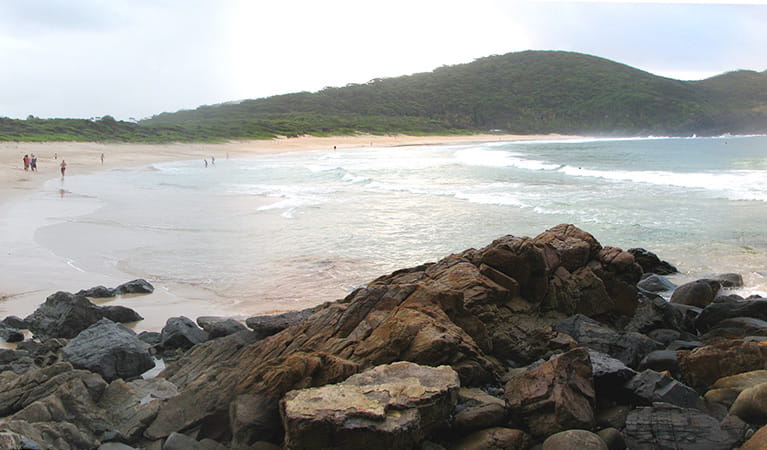
Booti Booti National Park holds important cultural significance for the Worimi Aboriginal people, who have lived on and used the land and waters for many thousands of years. Dozens of Aboringal sites exist within the park, including artefact scatters, stone quarries, tool sites, and shell middens. These are important markers of Aboriginal history in the region, demonstrating how land, water, plants and animals contributed to and continue to have significance for Aboriginal identity, spirituality, and lifestyle.
- Aboriginal culture Bring your students to this unique excursion in Booti Booti National Park, near Forster. They’ll experience the park through the eyes of an Aboriginal person on this Stage 2 (Years 3-4) Aboriginal culture Geography excursion.
- Junior ranger: Booti Booti coastal adventure tour Join us for a Junior ranger adventure, as we traverse the shores of Seven Mile Beach. Walk alongside a Discovery Ranger to find out what plants and animals live here, and how they survive in this magical environment.
Plants and animals protected in this park
Animals
-
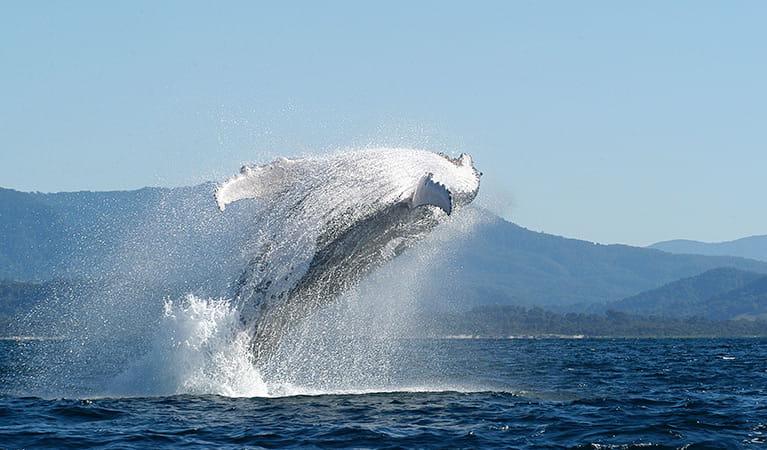
Humpback whale (Megaptera novaeangliae)
The humpback whale has the longest migratory path of any mammal, travelling over 5000km from its summer feeding grounds in Antarctica to its breeding grounds in the subtropics. Its playful antics, such as body-rolling, breaching and pectoral slapping, are a spectacular sight for whale watchers in NSW national parks.
-
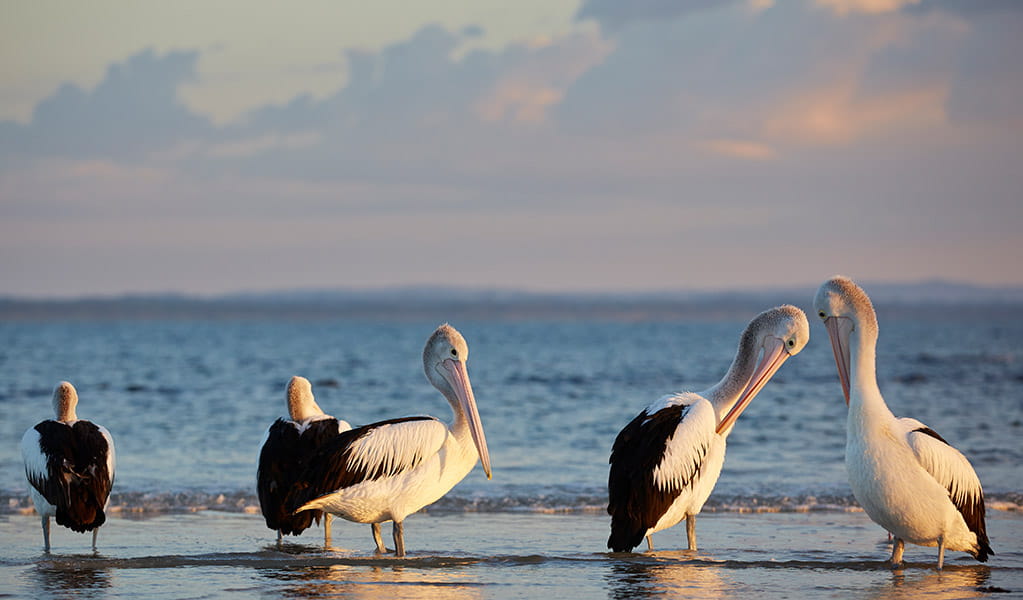
Australian pelican (Pelecanus conspicillatus)
The curious pelican is Australia’s largest flying bird and has the longest bill of any bird in the world. These Australian birds are found throughout Australian waterways and the pelican uses its throat pouch to trawl for fish. Pelicans breed all year round, congregating in large colonies on secluded beaches and islands.
-
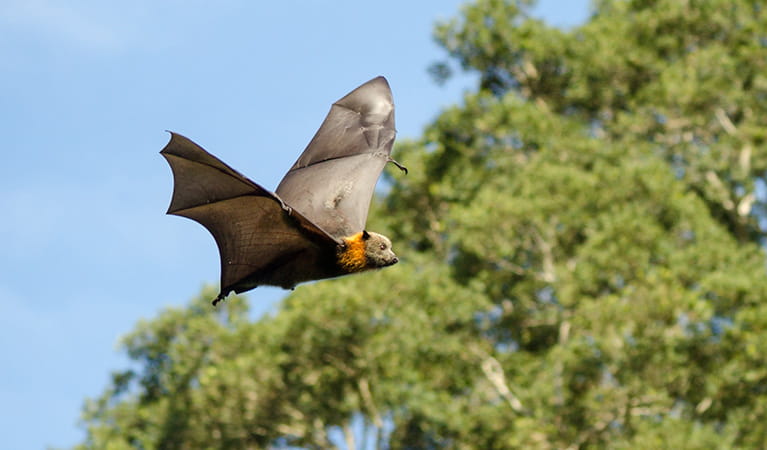
Grey-headed flying-fox (Pteropus poliocephalus)
The grey-headed flying fox is Australia's largest native bat, with a wingspan up to 1m. This threatened species travels up and down south-eastern Australia and plays a vital role in pollinating plants and spreading seeds in our native forests.
-
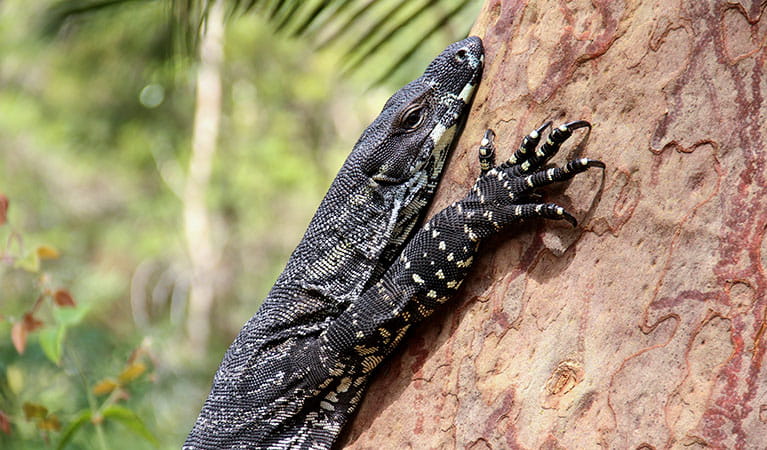
Lace monitor (Varanus varius)
One of Australia’s largest lizards, the carnivorous tree-dwelling lace monitor, or tree goanna, can grow to 2m in length and is found in forests and coastal tablelands across eastern Australia. These Australian animals are typically dark blue in colour with whitish spots or blotches.
-
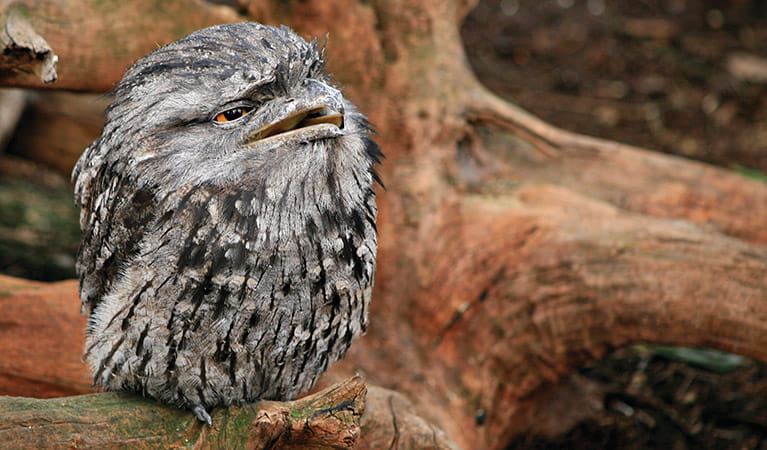
Tawny frogmouth (Podargus strigoides)
Found throughout Australia, the tawny frogmouth is often mistaken for an owl due to its wide, powerful beak, large head and nocturnal hunting habits. The ‘oom oom oom’ call of this native bird can be heard echoing throughout a range of habitats including heath, woodlands and urban areas.

